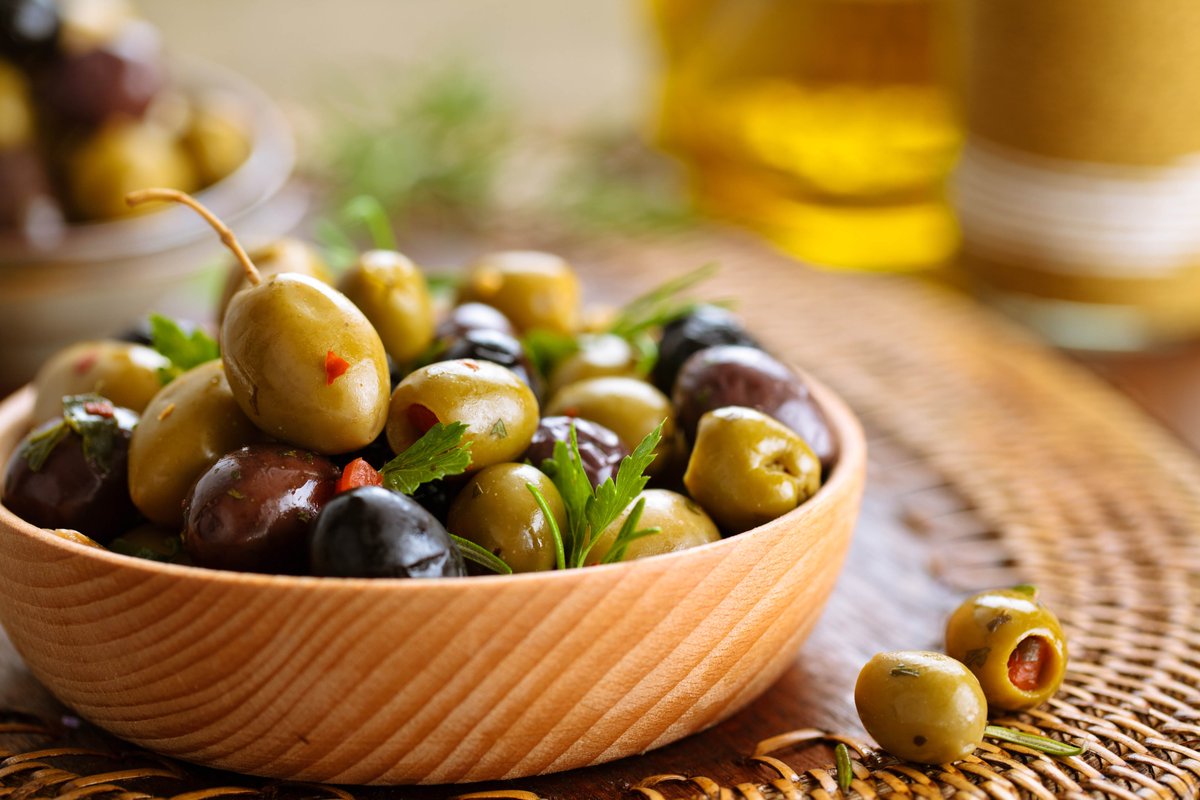ADVERTISEMENT
The olive tree has always been famous for its great benefits and nutritional values that benefit human life. It has been known over the years as a blessed tree in many cultures and countries worldwide. Therefore, in this article, we will learn about the benefits of this lucky tree and how to benefit from its fruits. We will also learn how to make canned olives and the ingredients for making canned olives.
The benefits of pickled olives
Green olives are a great mine of countless benefits, including:
* High content of nutrients, and the reason is that it is rich in most minerals, vitamins, and antioxidants, such as vitamin H, copper, iron, calcium, and others.
* A free-radical fighter and an effective delay in aging, rich in unique antioxidants and plant nutrients.
* Improving the level of thinking and memory because of its high content of (polyphenols), an antioxidant that reduces the oxidation and damage of nerve cells.
* Strengthen immunity.
* Control of appetite and weight loss, thanks to its richness in saturated fats that curb hunger and promote weight loss.
* Treatment of anemia for its richness in iron, which enters the composition of hemoglobin in the blood.
* Effective support for the digestive system, rich in fiber.
* Olives are rich in antioxidants and plant elements that significantly reduce inflammation. Hence, it plays a significant role in treating many diseases and relieving many symptoms.

How to make pickled olives at home
ADVERTISEMENT
the ingredients
Eight kilograms of green olives.
* One and a half kilograms of hot green pepper.
Six kilograms of yellow lemon.
* Five tablespoons of salt.
* Appropriate amount of water.
How to prepare
1. First, when buying green olives, it must be considered that the fruits are ripe with a greenish-yellow color, and the olives should be free from any scratches or spots.
2. The olives are washed well, filtered from the water, put back in regular containers filled with water, and left for three days to get rid of the bitterness of the olives, taking into account the renewal of the water on these days every day.
3. Preparing the brine solution and preparing it to preserve the olives by adopting the floating egg method. The egg is established and cleaned well beforehand when a quantity of salt is placed in the water. Then you watch. When the density of the brine becomes more significant than the egg’s density, the egg begins to rise from the bottom. It continues adding salt until the egg reaches the water’s surface, and then the density is excellent for preserving olives for a long time.
4. Then, a reliable tool is used to help press the olives to get rid of a good portion of the bitter-tasting liquid to reduce the bitterness of the olives. It is worth noting that this method improves the taste of pickled olives and helps them ripen faster.
5. Finally, the olives are placed in unique jars, preferably glass, to avoid the risk of the pickle interacting with the plastic. Then add the brine, lemon slices, and hot pepper pods with a bit of lemon juice and all the flavorings that improve the taste.

How to make stuffed green olives at home
the ingredients
* Two kilograms of ripe green olives.
* A kilogram of carrots.
* Half a kilogram of hot green pepper.
* salt.
* Half a cup of white vinegar.
* Half a cup of lemon juice.
* Appropriate amount of water.
* Six tablespoons of olive oil.
How to prepare
1. Initially, it is preferable to bring mature olives but large.
2. Soak the olives for three hours, then wash them well.
3. The olive extracting tool (a hollow tool) is prepared, which helps in removing the olive core.
4. Prepare a large bowl to soak the olives, in which the olives are soaked for three days, taking into account the change of water once a day during the three days.
5. Prepare the carrots by washing them well, peeling them, and then cutting them into a cylindrical shape with a tool designated for that so that their size is suitable for the olive filling.
6. Then mash the garlic, cut the hot pepper into small pieces, put it in the jar designated for keeping olives, and add the lemon slices.
7. Then the brine is prepared in the aforementioned floating egg method, lemon juice and vinegar are added to it, and it is poured over the olives in the last jars so that the olives are completely submerged.
8. Finally, the oil is placed as the last layer to keep the olives from interacting with the air and forming a mold layer on the surface. The jar is closed tightly and placed in a dry area away from moisture and high temperatures to preserve the pickled olives for as long as possible.

How to make canned olives in factories
1. First, you should choose the ideal type of ripe green olives, especially the large ones.
2. At first, the olives are transported in trucks to the factory after they are mechanically harvested. Water channels deliver it into the factory to protect the grains from bumps and bruises. It is worth noting that the running water method works to wash the olives well and to separate the olive kernels from the leaves and suspended impurities.
3. Then the fruits are sorted again, the large and well-ripened berries are purified, and the fruits with spots or scratches are disposed of.
4. After that, the selected olives are placed in an alkaline solution, immersed in a water well, and left in it for four to five hours as a maximum. This process helps relieve the bitterness of olives.
5. The olives are removed from alkaline water and then placed in plain water, which is renewed every day for three days.
6. Here, the pickling process begins by placing the olives in large bowls, then adding a brine solution consisting of salt, water, and white vinegar.
7. Finally, olives are packed in bottles intended for sale. Thus, we see from the preceding how the olive tree and its fruits have endless benefits that are reflected in human health with all goodness and wellness. We also hope that at the end of the article, we have provided you with all the information you want to know about the benefits of olives and how to make olives at home and industrially. Thank you for your follow-up and reading.



